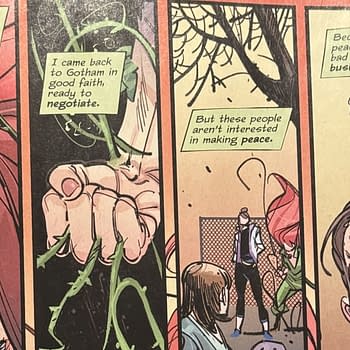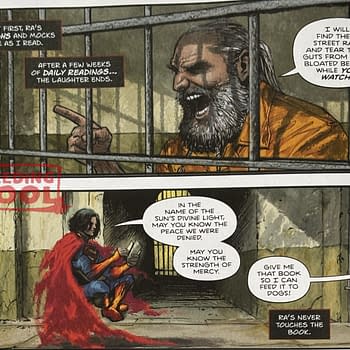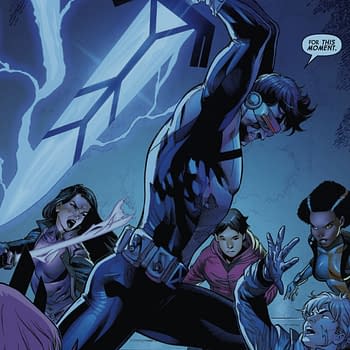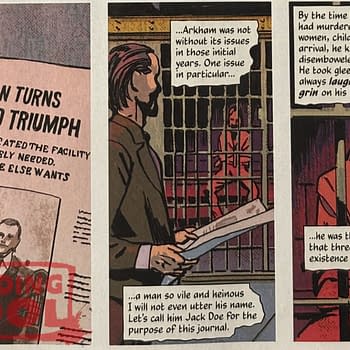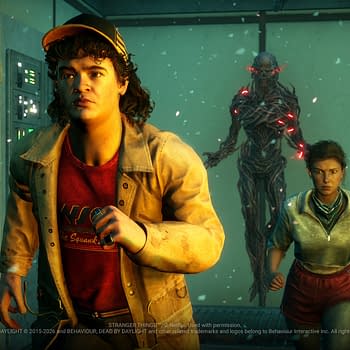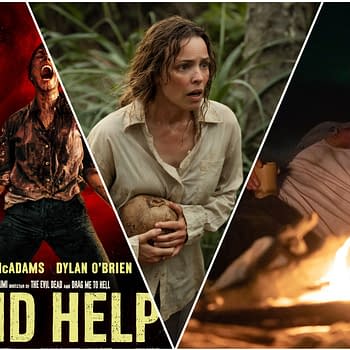Posted in: Movies, Recent Updates | Tagged:
A Very American Sailor Moon
Peter G writes,
It is said that, out of all the scripts and projects Hollywood sees a year, only 1% of them get optioned, and only 1% of those actually get made. As a result, there is a stunning amount of projects that never see the light of day, that make it past that first hurdle but curiously die in the second stage. Alien 3 had literally dozens of scripts before the one they settled on. There were numerous attempts at another Batman movie after Batman And Robin but before the Nolan trilogy. And each one brings to the table a reinterpretation — it takes something that already exists and attempts to bring it to a new audience while still appeasing the longtime faithful fans.
A lot of these projects are fascinating to read about, to wonder what might have been. Sometimes, you don't even have to imagine. Speaking as a devout fan of Teenage Mutant Ninja Turtles (I have first prints from #2 on of the Mirage run, verified authentic, thank you very much), such reinterpretations can work on their own merits or can wipe out. And I'm not just talking about the animated series and movies — Mirage's own original series was notoriously experimental, ranging from the nightmare visions of Michael Zulli to the madcap comedy of Hedden and McWeeney and everything in between.
But the above was born of different visions, artists following their own paths that they thought would yield results. What happens if you have something that already exists, already has a following, but you need, nay, are REQUIRED to somehow bring in a bigger following? What happens when artistry has to share the ride with commerce? Sometimes it can work, like the American House Of Cards. Othertimes, it tries but can't quite do it, like the American Life On Mars. Grab yourself a sandwich and a beer, and gather 'round, as I tell you about a curious footnote in animation history, an attempt at an American version of Sailor Moon.
Before I go any further, I need to tip the Peter G fedora to the fine and upstanding Rocky Solotoff. Mister Solotoff is a great guy with a huge animation pedigree (he was part of the Bakshi Mighty Mouse crew). He's also the founder and head of Toon Makers Studios, who took a job and found themselves in the middle of a story that would never go away. Mister Solotoff was kind enough to talk to me on the phone about the history of Sailor Moon USA. It seems the popular understanding of what happened is full of wrong conclusions — so much so, the Toon Makers staff who were part of it will read the articles and rate them based on how many times they make them laugh. I talked to the man himself, so if I make them laugh, I have no one to blame but myself.
The story begins in Japan in 1986, with a woman named Naoko Takeuchi, who had just graduated from university with a degree in chemistry and a license to be a pharmacist. Naoko wanted to be a manga-ka, and it was that year that she submitted her work, Love Call, to publisher Kodansha. She continued to work steadily, culminating in her work on The Cherry Project, a story about ice skating. While doing this, she decided she wanted to do a manga about a female heroine from outer space (the idea of making the costume resemble a school uniform was the idea of Fumio Osano, her editor). She created a one-shot that introduced the world to Minako Aino and Artemis the cat, Codename: Sailor V. It became a regular feature in RunRun.
The series caught the attention of Toei Studios. Toei was experiencing great success with Power Rangers, its sentai hero line-up. Basically brightly colored heroes exemplifying the ideals of teamwork, Toei was anxious to expand the genre beyond the young boys market. A Codename: Sailor V anime was in development (an opening sequence, end credit sequence, and an eyecatch were completed), and Toei approached Naoko about expanding the line-up into a sentai series for girls. She reworked the concept a bit, and in 1991, Nakayoshi published the first chapter of Sailor Moon. 1992 saw the anime debut on TV, and it was a smash. The series was being translated and broadcast all over the world.
Except one place.
America.
Fansubs of Sailor Moon started turning up at conventions, and everyone realized that there was potential here. But how to exploit it? The general feeling was that Sailor Moon wouldn't cross over to general American audiences, at least, not for the numbers needed to make it a continued success (this is not unreasonable, as the DiC dub only lasted a year in syndication and the series only thrived when it ran on Cartoon Network's Toonami programming block, where a smaller audience could sustain it. Even now, with all the hoopla surrounding Sailor Moon Crystal, merchandise is still in specialty shops in limited numbers instead of entire rows at Toys R Us and Walmart). So what to do?
And this is where things get strange.
In 1993, Renaissance-Atlantic Entertainment decided it wanted to take swing at it. By this point, Saban Entertainment was seeing huge success with their Americanization of Toei's Power Rangers. (This is the reason Sailor Moon USA is sometimes dismissively referred to as "Saban Moon." But Saban was only approached for funding and distribution. Everything about the series was Renaissance-Atlantic's idea.) After negotiating Toei for the animation rights and Bandai for the merchandising rights (Kodansha only handles the original manga), RAE went to work to make a version of Sailor Moon that would sell to American girls.
So what were some of the changes that were made? Well, there was the show presentation. RAE decided to make a curious hybrid — when showing the girls in their civilian identities on Earth, the scenes would be live action. When it came time for Sailor Moon, the girls would transform and it would become animated. Because sailor school uniforms aren't the norm in America, something had to be done to justify the "Sailor" part of the title. To this end, the girls, with one notable exception (which I will get to anon) had space windsurfers called Space Surfers. Somehow propelled by the sail, this was seen as enough to validate the name.
The biggest change, however, came to the central cast. American entertainment likes diversity and inclusion. Sailor Moon remained a blonde-haired, blue-eyed white girl. But the other scouts? Sailor Jupiter became a black girl. Sailor Mars was Asian. Sailor Venus became Latina. And Sailor Mercury…remember what I said about all but one girl getting a space windsurfer? Sailor Mercury became a red haired girl in a wheelchair who didn't let her disabilities get her down. I'm not kidding — one line her character says as she enters a room is, "Make way for the original party girl!". And when she transformed with the others, she couldn't fly a space windsurfer, but got a space chair that flew around and could shoot lasers. The cats, Artemis and Luna, were merged into a single character.
RAE came up with a story where Queen Beryl was attempting to conquer the planet Jupiter and enslave its inhabitants, as well as somehow incorporating Tuxedo Mask into things, then they hired Toon Maker Studios, a company they and Bandai had a long history with, to shoot it. A lot of online sites pin the changes on Toon Makers, but they were simply work for hire, all the creative decisions came from RAE. If the information about the show's story is sketchy, there's a reason for that — there was no actual pilot shot. According to Mister Solotoff, what they created was more of a proof of concept — it wasn't telling a story, but showing how the finished show would look and feel. As a result, a lot of plot details got filed under, "We'll figure this out if we go to series, we have to dazzle the folks at Saban, and we only have 17 minutes to do it!"
An interesting side note to this: Mister Solotoff is close friends with legendary American actress Adrienne Barbeau. She was taking some time off from acting because she had just had a baby, and Solotoff asked her if she wanted to help voice the POC. She said sure, and wound up doing the voices of Sailor Moon's mother and Queen Beryl.
A lot of Moonies read this and go, "Well, thank Serenity that never happened!" Well, it almost did. Saban ultimately rejected the series, but not due to its content. What made them balk was the budget — Toon Makers didn't get a lot of money to make the POC, and used every trick in the book to get it done. Going to series would have meant hiring union cast and crew for both the live action and the animated bits. Saban looked at the proposed budget, realized it would be cheaper to simply dub the original anime, and said, "Pass." And that was the end of Sailor Moon USA. (Well, more or less. The Sailor Moon logo was used by DiC for their dub.)
The series has taken on legendary status in the anime fandom. For years, it was like Sasquatch — people had heard of its existence, but no one ever really saw anything. Then, in 1998, a fellow by the name of Allen Hastings hosted a panel at Anime Expo in Los Angeles. Among the things he showed was the opening sequence for Sailor Moon USA. Realizing this was the best chance to preserve that this really happened, someone recorded the two-minute clip and it has circulated on the Internet since.
This is the closest we will ever get to seeing what Sailor Moon USA was like. Part of the deal for animation companies is they get to add their work to a demo reel to show other prospective clients what they can do. Mister Solotoff has confirmed that the POC exists in Toon Makers' vault as part of their demo reel. But it's a demo reel, which means it can't be shown to the general public. Mister Solotoff said he gets two or three phone calls a week from Moonies asking if they can see the "pilot" or if Toon Makers can post it on the Internet. And the answer is always a big fat NO. When the deal fell apart, the rights to the POC reverted (probably back to Toei, although no one is really sure who exactly has the rights now), and whoever holds those rights would have to make the decision. Unless you are a production company that can view their demo reel, that thing will never be seen by anyone else. Rumors that the "pilot" exists and is circulating out in the wild are completely false.
Our best look at the series came in 2013. A storage locker in Hawaii defaulted and it was auctioned off. Inside were animation cels from various cartoons like Street Fighter and the like, and a bunch from Sailor Moon USA. There was even a voice-over script found inside. The images you see here are courtesy the Peter G Private Collection from the Vault Of Pimps. More images and the voice over script can be found at moonsisters.org. The series was originally intended to have multiple vehicles, and one of which actually was made for the US market, the Moon Cycle. It is unknown what other merchandise was in development and how far along they were at the time.
And so we close on this odd footnote in animation history. How different the fandom would have turned out had this been the first exposure to Sailor Moon. As it is, people are torn between wanting it to stay buried and wanting it out so they can see it for themselves — I know I would have been very curious to see how it played out. All we have is what existed around it, the Bugs Bunny-shaped hole in the wall after what was there is gone. Unless there's another storage locker out there with more goodies, all we can do is wish upon the moon.
Thanks again to Rocky Solotoff for taking the time to talk with me.
Do you like cartoons? Who doesn't? Peter G is still doing strange things in the name of art, and his new animations, like his cult series One True Pairing, can be viewed on YouTube at Sine Timore Animation Studios.













